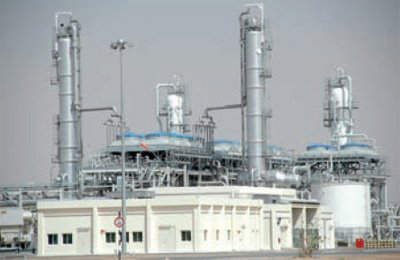
The Sajaa Gas Private Ltd Co (SajGas) gas processing plant has been constructed in the Sajaa area of the Emirate of Sharjah. SajGas is the builder owner and operator of the plant, which will carry out gas sweetening and sulphur recovery. The primary operation will involve the sweetening of feed gas by extracting hydrogen sulphide and removing carbon dioxide and also the production of sulphur pastilles.
The SajGas project required an investment of Dh415m ($113m). SajGas is the controlling company and is a joint venture established in mid-2004 between the Government of Sharjah and Crescent Petroleum, along with six prominent GCC investors.
GAS INPUT
The gas sweetening plant will process up to 600mmscd of gas in two parallel trains of units. The sweetened gas will then be further processed by the LPG plant before distribution into the Northern Emirates gas grid.
The raw input gas will be transported through a new 30in offshore and onshore pipeline over a distance of 85km from a new riser platform close to Crescent’s existing offshore facilities to Hamriyah, and then on to Sajaa for gas sweetening by SajGas.
The incoming pipeline terminates at a pig receiver and slug catcher. The slug catcher separates any liquids formed in the pipeline, although under normal operations no liquids are expected. The feed gas is then sent to the amine treatment facility within the plant. The SajGas plant is self contained for its requirement of power, water, steam generation and other utilities.
CONTRACTORS AND CONSTRUCTION
The plant is being constructed under a fixed price Engineering, Procurement and Construction (EPC) contract by Petrofac International Limited. The plant construction commenced in May 2004 and is scheduled to be completed in the fourth quarter of 2005 with operations commencing in the first quarter of 2006.
Petrofac Engineering & Construction, the division of the international oil services group, was awarded an $82m contract to build the company’s new gas plant at Sajaa. The project was managed by Crescent Petroleum on behalf of SajGas.
The contract was awarded after Petrofac successfully completed the basic design (FEED) package for the gas processing facility in 2003. Petrofac constructed an onshore gas receiving and processing facility including reception facilities, two gas sweetening trains, a sulphur recovery plant and associated utilities and infrastructure.
In January 2005 a gas turbine-generator with an output of 7.9MW was supplied to the project by Siemens Power Generation. This unit will supply power to the entire gas processing facility at Sharjah. Two of the main subcontractors for the project were Lahoud Engineering sql (MEI works) and Target & Jima Co LLC (civil works).
AMINE SWEETENING FACILITIES
The feed gas is processed through an Amine (MDEA) contactor where hydrogen sulphide and some of the carbon dioxide are removed. The amine unit has two 300mmscfd-capacity parallel trains, designed to reduce the hydrogen sulphide content to 4ppm or less, in line with industry standards. The resultant sweet gas is then analysed.
The amine stream, carrying the hydrogen sulphide and carbon dioxide, is stripped to regenerate an acid-rich gas stream for recovery of the elemental sulphur. The regenerated amine is then treated via high-level filtration, with the required make-up of fresh amine as necessary, and recycled back to the contactor.
SULPHUR RECOVERY FACILITIES
The acid-rich gas stream is passed to the sulphur recovery unit, designed for a total capacity of 350t a day of elemental sulphur.
This is a Claus Unit where the gas stream is burned under carefully controlled conditions, prior to passing over a reduction catalyst where the elemental sulphur is formed.
The sulphur is then condensed, while simultaneously generating steam, and runs down into a liquid sulphur storage pit. In the pit the sulphur is stripped to ensure that all remaining hydrogen sulphide (to the required environmental standards of less than 10ppm) is removed. The extracted pure liquid sulphur is pumped from the degassing / storage pit to three trains of high-grade pastillators.
Each train is capable of processing 120t of liquid sulphur a day, giving an overall output capacity of 360t a day. In these units the sulphur is sprayed onto special water-chilled belts where it instantaneously solidifies into pastilles of high strength and uniform size, free from dust. These are transported into four elevated concrete storage silos, from where they are gravity loaded via vibrating chutes into road vehicles for onward sale and export.

